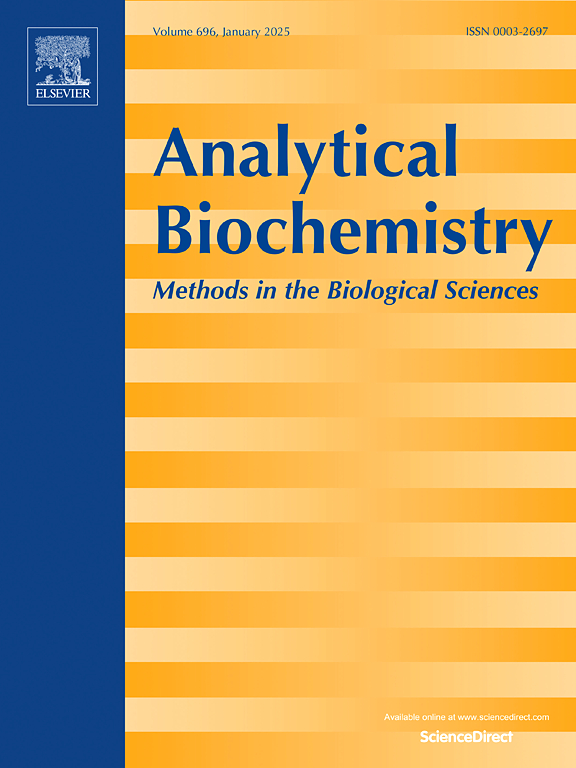Multiplex analysis of ovarian cancer patients using glycan microarray
IF 2.6
4区 生物学
Q2 BIOCHEMICAL RESEARCH METHODS
引用次数: 0
Abstract
Investigation of tumor-associated glycan antigens (TAGs) could be helpful for the development of sensitive cancer diagnostics and novel therapies. Glycan microarrays are effective methods for analyzing glycans and anti-glycan antibodies, which are immobilized arrays of oligo- or poly-saccharides on different substrates, making them a promising class of oncological biomarkers. Blood serum samples from patients (n = 203) with ovarian cancer (OvaCan) and healthy volunteers were analyzed using a glycan microarray containing 63 immobilized glycans to determine changes in anti-glycan IgG and IgM antibody profiles in OvaCan. Levels of anti-glycan IgG and IgM antibodies in OvaCan statistically differed from levels in healthy donors: the most prominent statistically significant difference for anti-glycan IgG antibodies was found for 6-O-su-Lec (AUC = 0.657, Se = 48.0 %, and Sp = 73.3 %). The AUC values for certain glycans investigated in diagnosing OvaCan indicated a fingerprint consisting of IgM antibodies to specific glycans, and the most specific anti-glycan IgM antibodies were Ley (AUC = 0.625, Se = 98.0 % and Sp = 45.0 %). The potential of these serological biomarkers to distinguish between OvaCan and other malignancies is still an unresolved issue that requires more large-scale studies to confirm and validate the use of these biomarkers in the diagnosis of different types of cancer.

糖聚糖微阵列对卵巢癌患者的多重分析。
肿瘤相关聚糖抗原(TAGs)的研究有助于开发敏感的癌症诊断和新的治疗方法。聚糖微阵列是分析聚糖和抗聚糖抗体的有效方法,它们是固定在不同底物上的寡糖或多糖阵列,使它们成为一类有前途的肿瘤生物标志物。使用含有63个固定化聚糖的聚糖微阵列分析卵巢癌(OvaCan)患者(n=203)和健康志愿者的血清样本,以确定OvaCan中抗聚糖IgG和IgM抗体谱的变化。OvaCan中抗聚糖IgG和IgM抗体水平与健康供者有统计学差异,其中6-O-su-Lec中抗聚糖IgG抗体差异最显著(AUC=0.657, Se=48.0%, Sp=73.3%)。在诊断OvaCan时,对某些聚糖的AUC值显示了针对特定聚糖的IgM抗体指纹图谱,其中抗多糖IgM抗体最特异性的是Ley (AUC=0.625, Se=98.0%, Sp=45.0%)。这些血清学生物标志物区分OvaCan和其他恶性肿瘤的潜力仍然是一个未解决的问题,需要更多的大规模研究来确认和验证这些生物标志物在不同类型癌症诊断中的应用。
本文章由计算机程序翻译,如有差异,请以英文原文为准。
求助全文
约1分钟内获得全文
求助全文
来源期刊

Analytical biochemistry
生物-分析化学
CiteScore
5.70
自引率
0.00%
发文量
283
审稿时长
44 days
期刊介绍:
The journal''s title Analytical Biochemistry: Methods in the Biological Sciences declares its broad scope: methods for the basic biological sciences that include biochemistry, molecular genetics, cell biology, proteomics, immunology, bioinformatics and wherever the frontiers of research take the field.
The emphasis is on methods from the strictly analytical to the more preparative that would include novel approaches to protein purification as well as improvements in cell and organ culture. The actual techniques are equally inclusive ranging from aptamers to zymology.
The journal has been particularly active in:
-Analytical techniques for biological molecules-
Aptamer selection and utilization-
Biosensors-
Chromatography-
Cloning, sequencing and mutagenesis-
Electrochemical methods-
Electrophoresis-
Enzyme characterization methods-
Immunological approaches-
Mass spectrometry of proteins and nucleic acids-
Metabolomics-
Nano level techniques-
Optical spectroscopy in all its forms.
The journal is reluctant to include most drug and strictly clinical studies as there are more suitable publication platforms for these types of papers.
 求助内容:
求助内容: 应助结果提醒方式:
应助结果提醒方式:


